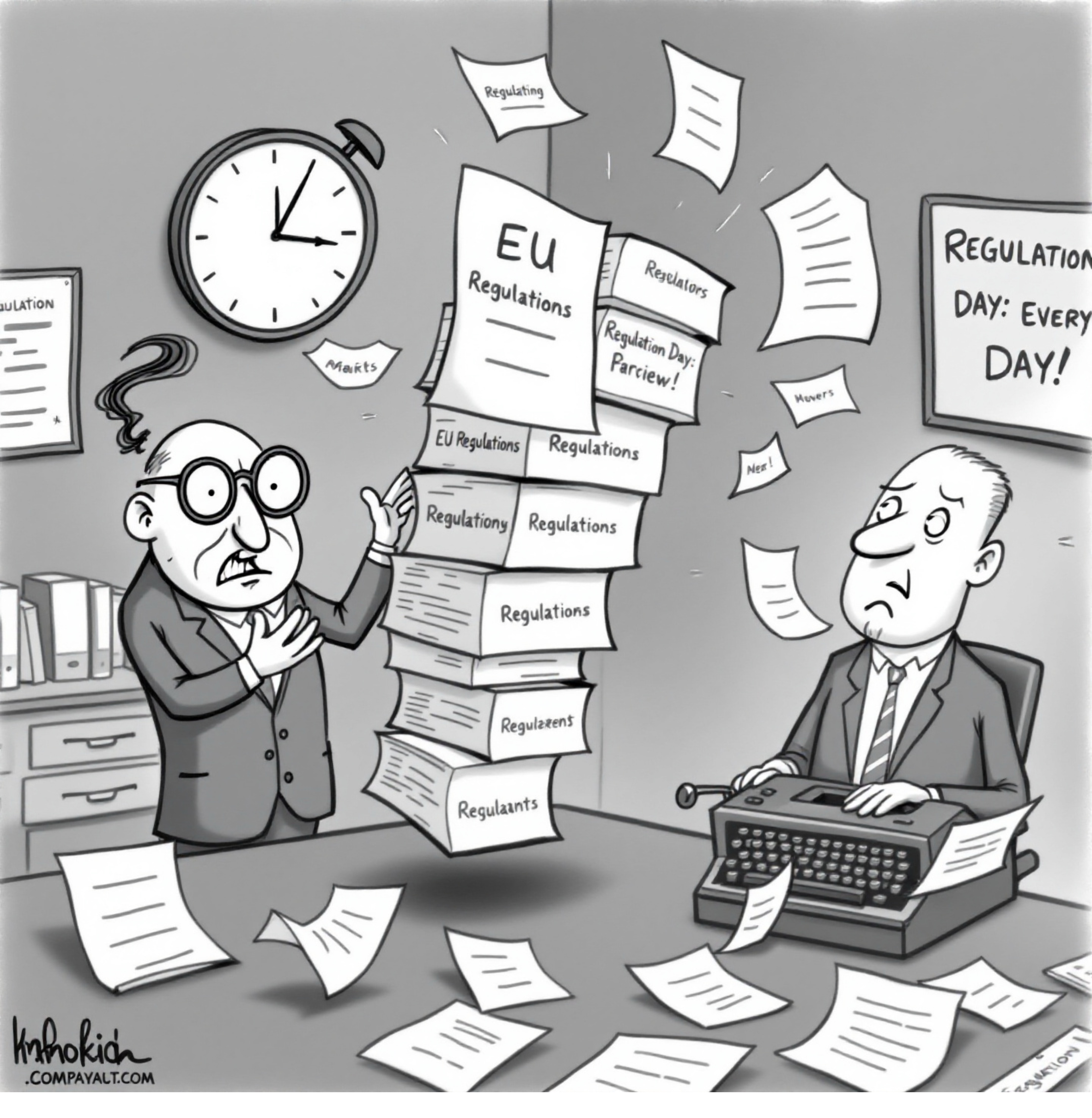EU Regulations: A Comedy of Bureaucracy and Complexity

Date: October 18, 2024
This cartoon highlights the overwhelming flood of EU regulations and how they impact everyone, from bureaucrats to citizens. Through humor, we emphasize the sheer volume of regulations that seem to pile up endlessly.
The Inspiration Behind the Cartoon
EU regulations often make headlines, but not always for the right reasons. While they are necessary for standardization and governance, the complexity and volume of these regulations sometimes become overwhelming for businesses and individuals alike. Our cartoonist uses exaggerated visual elements to depict this — stacks of papers growing larger by the second, symbolizing how the regulations seem never-ending.
Understanding the Impact of EU Regulations
With over 1,700 regulations currently in force, the European Union continually updates its legislative framework to address emerging challenges. These regulations span various sectors, including environmental standards, data protection, and market competition. While they aim to create a cohesive and fair marketplace, the constant influx can lead to bureaucratic fatigue.
Statistics at a Glance
- Number of Regulations: Approximately 1,700 EU regulations are active today.
- Annual Increase: The number of regulations has grown by 5% each year over the past decade.
- Compliance Costs: Businesses spend an estimated €20 billion annually on regulatory compliance.
Breaking It Down: The Cartoon's Key Elements
- The Tower of Regulations: The towering stack of papers symbolizes the immense bureaucracy that comes with EU governance.
- The Frustrated Bureaucrat: The character overwhelmed by the papers represents those tasked with implementing and enforcing these regulations, often finding themselves buried under an avalanche of paperwork.
- The Typewriter: A retro touch, the typewriter humorously represents outdated tools still perceived to be used for modern regulations.
- Floating Terms: Words like "Regulating," "Regulators," and "Regulants" highlight the pervasive nature of regulatory language in everyday life.
- Clock and Signage: The clock showing 9:00 and the sign reading "REGULATION DAY: EVERY DAY!" underscore the relentless and time-consuming nature of regulatory work.
The Balance Between Regulation and Innovation
While regulations are essential for ensuring safety, fairness, and environmental protection, there is an ongoing debate about finding the right balance. Excessive regulation can stifle innovation and burden businesses, particularly startups and SMEs, which may lack the resources to navigate complex legal landscapes. Conversely, insufficient regulation can lead to market failures, environmental degradation, and social injustices.
Case Studies
Case Study 1: Data Protection
The General Data Protection Regulation (GDPR) has set a global standard for data privacy. While it has empowered individuals to control their personal data, businesses have faced significant compliance challenges.
Case Study 2: Environmental Standards
EU environmental regulations have driven advancements in green technologies. However, industries like manufacturing have had to invest heavily to meet stringent emission standards.
Future of EU Regulations: A Path Forward
Looking ahead, it is crucial for the EU to refine its regulatory framework to address several ongoing concerns:
- Simplification and Accessibility: There is a need for simplifying regulatory language and making guidance more accessible. Reducing bureaucratic hurdles would significantly benefit SMEs and startups.
- Agility in Lawmaking: As the world changes rapidly, especially in technology and environmental areas, the EU must create more agile frameworks. Laws and regulations need to keep pace with innovation while avoiding unnecessary burdens.
- Public Engagement: Increasing transparency and public engagement during the regulation-making process can help ensure that rules are well-crafted and serve the common good. This engagement can reduce the perception of regulations as arbitrary or overly burdensome.
Conclusion: Humor as a Lens to Reflect on Bureaucracy
While the humor in this cartoon may bring a smile to your face, it also sparks a serious conversation. EU regulations, while often burdensome, are a necessary part of creating a functional and equitable society. Finding the right balance between necessary oversight and excessive regulation will remain a challenge, but it’s one worth tackling head-on.
Join the Conversation
What are your thoughts on EU regulations? Do you find them helpful or a hindrance? Participate in our poll to see how others perceive the impact of EU bureaucracy on daily life and business operations.
Back to Home